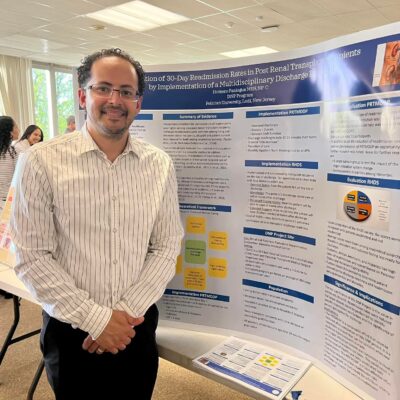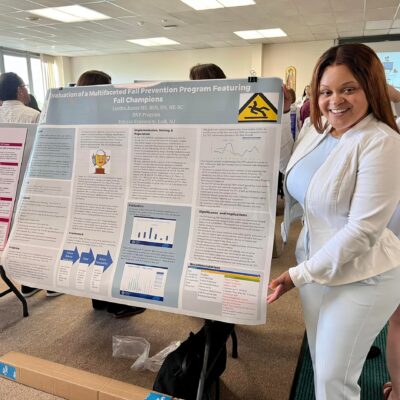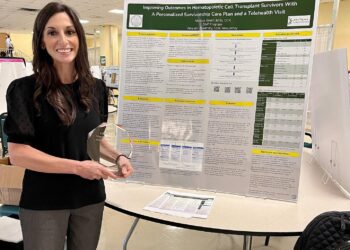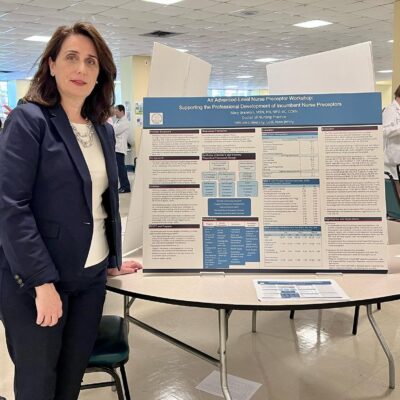Forward
On behalf of the School of Nursing, I thank you all for viewing our DNP Project Album. We are extremely proud of all of our graduates but most especially those who have achieved the Doctor of Nursing Practice degree. The list of alumni from this program is truly a “Who’s Who” in the field of Nursing, and we feel privileged that these individuals chose Felician University to achieve their DNP degree.
The level of scholarship in the DNP projects is outstanding and has definitely added to body of evidence that is the basis for professional nursing practice.
– Dean Mihal
EdD, RN Dean, School of Nursing

Christine C. Mihal

Patricia Drabik, DNP, RN, NEA-BC
Class of 2019
Vice President/Chief Nursing Officer, Christian Health Care Center
Purpose
To improve the nurse recognition provided by nurse leaders to promote engagement of the professional nursing workforce.
Methodology
Four nurse managers at Saint Joseph’s Wayne Medical Center were inserviced on meaningful recognition before implementation
of a recognition toolkit project over 12 weeks with embossed thank you notes. Staff nurses were surveyed before and after the project.
Results
There was a significant positive difference in the meaningful recognition scores after the implementation of the thank you initiative for Baby Boomers (p=0.0009). Overall ANOVA scores of the Press Ganey Overall 9-10 Global Scores and courtesy and respect scores run by quarter showed no significant difference (p=0.6723) pre and post intervention, but when run by unit, there was a significant improvement (p=0.0006).
Implications for Practice
This evidence-based project created a new practical approach for engaging and supporting the nursing workforce. The simple practice of the managers engaging their staff with meaningful recognition reignited the nurses’ passion for the nursing profession.

Melinda S. Weber, DNP, RN, APN, AOCN, C.
Class of 2016
Director of Care Transformation,
John Theurer Cancer Center
Purpose
To provide a comprehensive and individualized evidence-based Transition Support Care Plan (TSCP) for terminally-ill Phase One cancer patients transitioning to EOL care, in collaboration with the Phase One oncologist, to facilitate a dignified and personalized EOL transition.
Methodology
A TSCP was created for each patient including follow-up visits with the Phase One oncologist with on-going collaboration with hospice care. The National Comprehensive Cancer Network (NCCN) (2012) distress assessment tool was used upon initial patient assessment, again one to two weeks after the initial meeting, and four weeks after the initial meeting to measure patient distress. In addition, pre-TSCP data was obtained and analyzed to assess the number of Phase One patients that sought emergency care for relief of intolerable, intractable and uncontrolled incurable Stage IV advanced cancer symptoms the previous year.
Results
Statistical analysis demonstrated decreased distress in all TSCP patients, as well as a decrease in emotional and physical symptoms. The pre-TSCP data revealed 32 of the 99 Phase One patient ER admissions were due to intolerable, intractable and uncontrolled incurable Stage IV cancer symptoms.
Implications for Practice
Creation of a TSCP resulted in decreased distress and decrease demotional and physical symptoms in these Stage IV incurable advanced cancer patients. The TSCP/EOL care paradigm can prevent/avoid unnecessary admissions and facilitate immediate EOL symptom management in the ER and transfer to comprehensive hospice services.

Akua S. Danso-Manu DNP, RN
Class of 2019
Quality and Standards Nurse Coordinator
Saint Barnabas Medical Center
Purpose
To implement a Caregiver Advocacy program to assess distress among family members caring for patients with Alzheimer’s disease and to provide meaningful resources to enable them with managing the patient and reducing distress associated with the caregiver role.
Methodology
A Caregiver Resource Manual with meaningful resources was provided to those identified as caregivers. A Pre and post assessment was completed using the 22 item Zarit Burden Interview Tool after the participants had utilized the Caregiver Resource Manual. The goal was to see if utilizing the resource manual helped to decrease the stress related to the caregiver role.
Results
Data was analyzed by descriptive and inferential statistics. A paired t-test was used to determine if the interventions made a statistical difference in reducing caregiver distress. There was a decrease in the overall mean score of the post survey results. This indicates a decrease in the stress level among the caregivers (t=2.23, p=0.03).
Implications for Practice
A Caregiver Advocacy Program can be implemented with different populations and improves care quality in all stages of life. It supports the IOM Future of Nursing and Healthy People 2020 goals and QSEN competencies. The nurse leader should develop strategies to ensure sustainability of programs.

Clare Rovito, DNP, APN, ANP
Class of 2019
Nurse Practitioner
The Park Medical Group
Purpose
To decrease the 30-day Subacute Readmissions in an outpatient facility by using an APN Project Leader while applying evidence based transitional care processes.
Methodology
This was a Quality Improvement DNP Project based on Lippitt’s Model of Planned Change to determine the effects of APN leadership within the Interdisciplinary Team. It featured the immersion of an APN into a subacute facility over a 12-week period.
Results
Of the patients recruited, 30-day outcomes were divided into three groups and analyzed. They were then redistributed to quantify those patients whose outcomes justified a referral to hospice during the 30-day window. The breakdown included patients readmitted plus hospice referrals (n=5) and those not readmitted (n=4).
This new configuration displayed a significant difference in the 30-day outcomes as well as the LACE variable comorbidity scores t (4) =2.95, p=0.0418. The 30-day readmission rates were decreased using hospice as a referral source. The Interdisciplinary Team “Strongly Agreed (82%) and “Agreed” that having an APN/DNP Project Leader onsite daily improved the coordination of care and overall outcomes. Application of the Lippitt’s Model of Planned Change and the use of the LACE Scoring Tool were significant to the success of this project.
Implications for Practice
Skilled nursing facilities will need to provide quality encounters to reduce readmissions and optimize facility reimbursements or payments. This quality improvement project restructured the existing Interdisciplinary Team processes to include the APN/DNP Project Leader for a 12-week period with improved patient-centered outcomes.

Pauline P. Patterson, DNP, MSN, CRNA
Class of 2017
Chief CRNA at Richmond University Medical Center
Envision Physician Services
Purpose
To determine if callbacks from Post Anesthesia Care Unit (PACU) nurses are decreased with the implementation of a Specific PACU Standardized Written Handoff Checklist, when used in concurrence with verbal handoff, as compared to the current practice of a verbal handoff without a standardized written checklist.
Methodology
In a 10-bed PACU, the Anesthesia Providers completed the handoff checklist intra-operatively and handed it off to PACU nurses. Based on the completeness of the checklist, the PACU Nurses marked “Yes”, for callback or “No”, if callback was not necessary. The data collected from weeks two, four, and eight of the implementation phase were randomly selected to be compared to the data collected in the pre-implementation phase, in order to critically analyze the difference in the callbacks between the preimplementation phase and the implementation phase. Post implementation, a questionnaire was administered to the PACU Nurses.
Results
The results revealed that specific post-anesthesia care unit standardized written handoff is directly related to reduced callback from the PACU nurse to the operating room. The postimplementation PACU nurse questionnaire revealed 89% (8 out of 9) agreed that utilization of a standardized written tool decreases information omission, and 100% (9 out of 9) believed that the tool resulted in decreased nurse callback.
Implications for Practice
The change initiative project reinforced the need for standardized handoff upon the transfer of patient care between healthcare professionals in the immediate post-operative care area.

Lauren Van Saders, DNP, APN-C Class of 2016 Assistant Professor of Nursing Felician University
Purpose
To improve transitions of care for patients with dementia following acute hospitalization to prevent emergency department visits and readmission.
Methodology
Adults aged 65 and older with the diagnosis of cognitive impairment and/or dementia received an intervention from an Advanced Practice Nurse (APN) with a high level of skill in assessment, diagnosis and treatment that included house calls and telephone follow-up with patients and caregivers within the 30 day period of time following hospitalization as a strategy to decrease the incidence of Emergency Department (ED) visits and re-hospitalization.
Results
Six patients (N=6) with the diagnosis of cognitive impairment and/or dementia were provided the APN intervention with five of the six patients without re-hospitalization or an ED visit. One patient was readmitted to the hospital for the new onset of seizures that could not be managed at home. Observational data to include functional status and home safety did not provide a correlation to the outcome of prevention of readmission to the hospital, as the one patient rehospitalized was the most functional of the patients included in the project.
Implications for Practice
Although the sample of patients was very small, the data collection limited by utilization of one APN, and a short timeline to implement the project, the outcome data indicate that intervention by a care provider following a recent hospitalization is helpful in preventing re-hospitalization in the 30 days following acute hospitalization.

Shirley Allen, DNP, RN Class of 2021 Staff Nurse Bronxcare Hospital
Purpose
To garner nurses’ perception of the impact of telehealth on nurse service quality.
Methodology
A modified SERVQUAL instrument, Telehealth Nursing Service Quality (TNSQ), was used to capture nurses’ perceptions and expectations of telehealth. TNSQ had 5 dimensions of service quality used to determine nurses expectations (E)and perceptions (P) of nurse service quality. A gap between nurses’ perception and expectation (P-E) would determine if nurses had a negative or positive perception of nurse service quality when telehealth is used to provide nursing services to patients. Nurses who were members of the New Jersey State Nurses Association (NJSNA) and who have used telehealth to provide patient care were invited to participate in this online survey.
Results
Significant differences were found between nurses’ perceptions and nurses’ expectations in the Tangibles, Assurance and Reliability dimensions. These dimensions had negative gap scores, Tangibles (-0.92), Assurance (-0.59), Reliability (-0.32). These dimensions contributed to an overall gap score of -0.32 which indicated that nurses had negative perceptions of nurse service quality given to patients when telehealth is used. Problems with faulty, cumbersome, poorly designed equipment and lack of support led to nurses’ negative perception.
Implications for Practice
Nurses need to have a positive perception of nurse services offered to patients while using telehealth. Problems relating to equipment need to be addressed. Procedures and policies relating to telehealth need to be revised, updated and implemented to better facilitate a positive patient nurse experience. There should be ongoing training in telehealth for nurses. Nursing educational programs should include a telehealth component ideally inclusive of devices used in the nurses’ daily, work and educational lives.

Michelle Wheeler, DNP, RN Class of 2021
Diabetic Nurse Educator Advocate Medical Group
Purpose
To implement a structured transition plan using the transitional assessment and a transition ready checklist.
Methodology
A transitional assessment checklist which contained questions on self-care behaviors, personal healthcare and transition readiness was provided to patients with transitioning type I diabetes between ages 18-24. Participants were also provided with a transition ready checklist at the last appointment before discharge from the pediatrics provider. Participants were monitored after discharge by the clinic nurse practitioner for follow-up with adherence to the care plan and AIC rates.
Results
Follow-up for participants given the checklist was 84% versus follow-up rate of 36% for participants not given a checklist. AIC levels decreased by 9% for those given the checklist, whereas the group not given the checklist had an AIC increase of 27%.
Implications for Practice
Transitional plans are beneficial to transition young adults with type I diabetes into adult care. Structured plans can help control unfavorable outcomes.

Homero Paniagua, DNP, Class of 2022, APN, Cooperman Barnabas Medical Center
Purpose
The purpose of this DNP Project is to determine if the implementation of a post-renal transplant multidisciplinary discharge protocol could help reduce early hospital readmissions within 30-days in new renal transplant recipients. This project also studied if patient perception in regard to readiness for discharge as evident by the Readiness for Hospital Discharge Scale survey results, has an impact on hospital readmissions.
Methodology
This DNP Project was performed in two simultaneous phases. The phases were to implement a post renal transplant multidisciplinary discharge protocol or “PRTMDDP” and to provide a Readiness for Hospital Discharge Scale survey. The methodology of this DNP Project was a retrospective review of 30-day readmission rates in renal transplant recipients 6 months before implementation. A comparison between readmission rates after implementation of this DNP Project was reviewed. Patient perception of readiness for hospital discharge was also reviewed based on the Readiness for Hospital Discharge Scale Survey responses. Recruitment and consent of participants to complete the RHDS was done by the team leader at the bedside on the day of discharge. The theory of Human Caring by Jean Watson served as the theoretical framework for this DNP Project.
Results
Results of this DNP Project showed a reduction in readmissions by 8% after implementation of the PRTMDDP. An association between the reduction of readmissions and my DNP project is possible. The RHDS identified areas where transplant recipients have a low perception of readiness for discharge. The two lowest scoring domains were Personal Status and Perceived Coping Ability. African Americans had the highest rate of readmissions therefore identifying a racial disparity. Both results of the PRTMDDP and RHDS provided areas for future research in reduction of readmissions of renal transplant recipients.
Implications for Practice
Among the areas of implications from this DNP Project is the promotion and sustainability of the Post Renal Transplant Multidisciplinary Discharge Protocol or PRTMDDP. The completion of this DNP Project has highlighted the essential leadership quality of identifying problems and creating solutions that are sustainable for an organization. The RHDS survey responses and comparing readmissions was the second phase of this DNP Project. Among the responses of the subjects, Personal Status and Perceived Coping Ability were among the lowest scoring aspects of the RHDS survey. These areas could serve as an implication of a future project as an area for improvement.

Lendra James, DNP, Class of 2022, Nurse Leader
Purpose
A surge in patients with COVID-19 at a community hospital led to an increase in falls and the utilization of fall champions as a prevention strategy. Fall champions were able to enhance the use of purposeful hourly rounding, Johns Hopkins Fall Risk Assessment Tool interventions, and “Stay With Me” campaign by engaging and empowering staff.
Methodology
This quality improvement project was a program evaluation that aimed to evaluate the Fall Prevention Program (FPP) which utilized Fall Champions to impact safety interventions. The aim was to evaluate if the Fall Prevention Program Featuring Fall Champions addressed the gaps between fall risk assessments and fall prevention interventions. Kurt Lewin’s theory of change was the framework for this quality improvement project. The theory involves three stages of change: unfreezing, change and refreezing. The key component of the FPP was identifying champions and educating them on the fall champion toolkit. Using a pre and post survey design, the study was evaluated for effectiveness.
Results
The program contributed to a reduction in the overall number of falls. Toileting related falls decreased from 50% to 44% during program implementation. Units that utilized fall champions had an equal or lower number of falls compared to units that did not utilize champions.Teamwork and engagement was increased as a result of the program.
Implications for Practice
The nurse led fall champion initiative was associated with reduced falls. The Fall Prevention Program Featuring Fall Champions addressed the gaps between fall risk assessments, fall prevention interventions, engagement, and teamwork.Failure to properly identify a patient at moderate or high risk for falls can have serious implications if a fall occurs especially a fall with injury. As part of an innovative strategy, the use of champions allows leaders to capture the mindset necessary for meaningful sustainability to the organization.

Melissa Baker, Class of 2023
Purpose
To evaluate the effects of adding a telehealth visit to supplement a survivorship care plan on patient self efficacy and confidence in survivorship information
Methodology
Baseline testing was performed on all participants to evaluate perceived self efficacy in managing symptoms and managing medications and treatment and confidence in survivorship information in allogeneic transplant survivors. Next, participants received a personalized survivorship care plan. Survey tools that were used at baseline were repeated to assess the effect of the intervention on self efficacy and confidence in survivorship knowledge. Next, a telehealth session was with the APN to reiterate information in the survivorship care plan. Survey tools were again repeated to assess scores after the intervention.
Descriptive and inferential statistics were done to assess change scores after the survivorship care plan and the teleheatlh session.
Results
The mean scores for self-efficacy of symptom management, self-efficacy for managing medications and treatment, and confidence in survivorship information were substantially higher after implementation of the care plan and the telehealth visit compared to baseline.
Implications for Practice
The use of a survivorship care plan may help to streamline patient care, but efforts need to be made to decrease the time burden associated with the creation of this tool.

Mary Brennan, Class of 2023, Nurse Educator, NewYork-Presbyterian Hospital
Purpose
The goal of the Advanced-Level Nurse Preceptor Workshop (ALNPW) was to provide an educational program that met the continuing education needs of incumbent nurse preceptors, supported the professional development of nurses, improved patient safety, and reduced turnover and burnout for incumbent nurse preceptors.
Methodology
Malcolm Knowles’ Theory of Andragogy and Patricia Benner’s Novice to Expert Theory provided scientific structure in guiding an appropriate educational program for incumbent nurse preceptors, offered academic concepts regarding adult learning, motivation to learn, and experiential situations advancing nursing professionalism and competence. This project focused on improving the professional nurse preceptor’s self-assessment competency using the Preceptor Self-Assessment Tool (PSAT), offered three times to attendees, and a readiness instrument, the Cotter Preceptor Selection Instrument (CPSI), presented once during the workshop. In addition, the workshop provided preceptors strategies to guide them in their roles and responsibilities and teaching-learning styles and examined effective communication, evaluation, and feedback techniques.
Results
The results of the repeated measures ANOVA was not statistically significant (F(2,16) = 1.92, p=0.18), indicating no significant improvement in the overall PSAT score over time. However, the ALNPW showed clinical significance in supporting the continuing educational needs of incumbent nurse preceptors, demonstrated by the overall increase in mean scores between the pre (M= 168.55, SD=16.86), post (180.90, SD=11.57), and four-week follow-up (M=182.00, SD=16.26) PSAT scores. Clinical significance was also evident through participant feedback and program evaluation.
Implications for Practice
To support the professional development of incumbent nurse preceptors, executive nurse leaders need to utilize EBP tools and research to develop structured educational programs, implement interventions to reduce new nurse and nurse preceptor turnover rates, support scientific research in developing valid and reliable tools to assess nurse preceptor burnout and competency, and create a hospital-wide nurse preceptor committee to support and strengthen the preceptorial role. In addition, executive nurse leaders need to recognize incumbent nurse preceptors as primary stakeholders in the development and implementation of educational programs and to include them in creating or restructuring institutional, educational programs to meet preceptor professional development needs.
